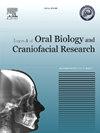颞及颞下区孤立性纤维性肿瘤:一例罕见病例报告及复习
Q1 Medicine
Journal of oral biology and craniofacial research
Pub Date : 2025-02-19
DOI:10.1016/j.jobcr.2025.02.008
引用次数: 0
摘要
孤立纤维性肿瘤(SFT)是一种罕见的良性梭形细胞肿瘤,最初被认为起源于间皮细胞,但后来被认为是间质细胞。虽然在头颈部不常见,但SFTs通常出现在口腔、眼眶和鼻窦旁。肿瘤的成像特征,如在超声和MRI中看到的,通常可以模拟血管病变,导致诊断困难。本文报告一例36岁女性,左侧颞区出现无痛性逐渐增大的肿块。影像学提示颞下区梭状低回声病变,可能累及颞骨和咀嚼间隙。手术切除采用Alkayat-Bramley入路并颧弓截骨以获得更好的通路。组织病理学显示胶原间质中有梭形细胞、血管间隙、多核巨细胞和出血区,免疫组化标志物(Vimentin、S100、CD34、BCL2和STAT6)阳性证实为SFT。术后恢复顺利,随访无复发。头部和颈部的SFTs通常表现为非特异性症状,因为它们生长缓慢且缺乏对重要结构的压迫。影像学特征可能提示血管病变,但明确诊断需要组织病理学和免疫组织化学证实。手术切除仍然是治疗的选择,放射治疗保留给有挑战性的病例。虽然化疗的疗效有限,但由于复发的可能性,特别是恶性肿瘤,完全切除并长期随访是至关重要的。本病例强调了包括SFT在内的头颈部病变鉴别诊断的重要性,并强调了组织学分析在实现准确诊断中的作用。本文章由计算机程序翻译,如有差异,请以英文原文为准。
Solitary fibrous tumor of temporal and infratemporal region: A case report and review of rare entity
Solitary fibrous tumor (SFT) is a rare, benign spindle-cell neoplasm initially thought to be of mesothelial origin but later recognized as mesenchymal. While uncommon in the head and neck region, SFTs typically present in the oral cavity, orbit, and paranasal sinuses. The tumor's imaging characteristics, such as those seen in ultrasound and MRI, can often mimic vascular lesions, leading to diagnostic challenges. This report presents a case of a 36-year-old female with a painless, gradually enlarging mass in the left temporal region. Imaging suggested a fusiform hypoechoic lesion in the infratemporal region, likely involving the temporal bone and masticator space. Surgical excision was performed using the Alkayat-Bramley approach with zygomatic arch osteotomy for better access. Histopathology revealed spindle cells in a collagenous stroma with vascular spaces, multinucleated giant cells, and hemorrhagic areas, confirmed as SFT by positive immunohistochemical markers (Vimentin, S100, CD34, BCL2, and STAT6). Postoperative recovery was uneventful, and there was no recurrence at follow-up.
SFTs in the head and neck often present with nonspecific symptoms due to their slow growth and lack of compression of vital structures. Imaging features may suggest a vascular lesion, but definitive diagnosis requires histopathological and immunohistochemical confirmation. Surgical excision remains the treatment of choice, with radiotherapy reserved for challenging cases. While chemotherapy has limited efficacy, complete resection with long-term follow-up is crucial due to the potential for recurrence, especially in malignant forms. This case highlights the importance of including SFT in the differential diagnosis for head and neck lesions and underscores the role of histological analysis in achieving an accurate diagnosis.
求助全文
通过发布文献求助,成功后即可免费获取论文全文。
去求助
来源期刊

Journal of oral biology and craniofacial research
Medicine-Otorhinolaryngology
CiteScore
4.90
自引率
0.00%
发文量
133
审稿时长
167 days
期刊介绍:
Journal of Oral Biology and Craniofacial Research (JOBCR)is the official journal of the Craniofacial Research Foundation (CRF). The journal aims to provide a common platform for both clinical and translational research and to promote interdisciplinary sciences in craniofacial region. JOBCR publishes content that includes diseases, injuries and defects in the head, neck, face, jaws and the hard and soft tissues of the mouth and jaws and face region; diagnosis and medical management of diseases specific to the orofacial tissues and of oral manifestations of systemic diseases; studies on identifying populations at risk of oral disease or in need of specific care, and comparing regional, environmental, social, and access similarities and differences in dental care between populations; diseases of the mouth and related structures like salivary glands, temporomandibular joints, facial muscles and perioral skin; biomedical engineering, tissue engineering and stem cells. The journal publishes reviews, commentaries, peer-reviewed original research articles, short communication, and case reports.
 求助内容:
求助内容: 应助结果提醒方式:
应助结果提醒方式:


